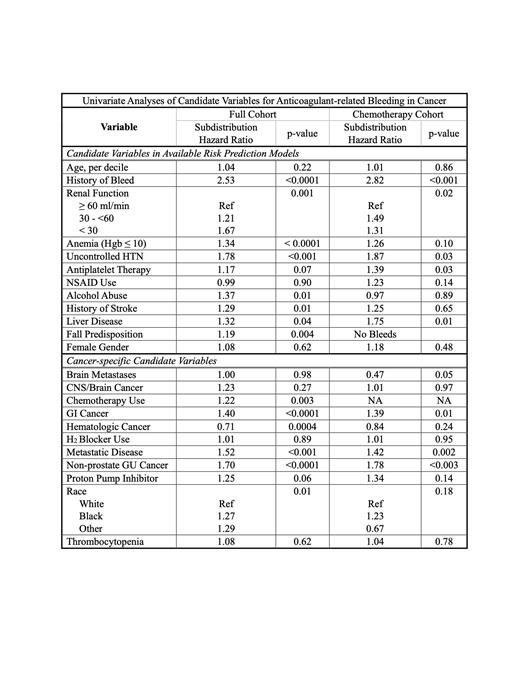Background:
Patients with cancer-associated thrombosis (CAT) have a high risk of recurrent venous thromboembolism as well as anticoagulant-related major bleeding. Thus, initiation and maintenance of anticoagulant therapy requires careful consideration of the risk versus benefit of therapy. Prior literature demonstrates that existing bleeding risk models have mediocre to moderate predictive performance for anticoagulant-related bleeding in patients with cancer. Patients with cancer have unique risk factors for bleeding that are absent in many of these models. Thus, we aimed to evaluate the association candidate traditional and cancer-specific risk factors with anticoagulant-related bleeding in a large cohort of patients with CAT.
Methods :
Using a nationwide cohort of US Veterans, we identified patients diagnosed with CAT with a new prescription for anticoagulant therapy between 2012 and 2020. Eligible anticoagulant therapy included a prescription for at least 30 days of: direct oral anticoagulants (DOACs), direct selective factor Xa inhibitors, low molecular-weight-heparin (LMWH), or vitamin K antagonists (VKA). Patients with outpatient prescriptions for anticoagulation within the six months preceding CAT were excluded. We further identified a subgroup of patients on chemotherapy around the time of CAT diagnosis, chemotherapy cohort. Using the methods of Fine and Gray, we assessed the association between candidate risk factors and clinically significant anticoagulant-related bleeding using competing risk analyses to account for the competing risk of death. Anticoagulant related bleeding was identified using previously validated international classification of disease (ICD) coding, with position dependent on site of bleed.
Results :
We identified a cohort of 11,731 patients with CAT, of whom 4,298 patients received anti-cancer systemic therapy within 6 months before to 12 months after CAT diagnosis. The most common malignancies represented in the full cohort included lung (23%), gastrointestinal (14%), and prostate (11%). Most patients received anticoagulant therapy with LMWH (47.7%), followed by DOACs (26.8%), VKAs (24.5%), and fondaparinux (1%). When assessing anticoagulant trends over time, DOACs were the treatment of choice by 2018 with 45.3% of patients receiving initial therapy with a DOAC and further increased to 78.1% by 2020.
The 6-month and 12-month cumulative incidence of bleeding in the full cohort was 7% (CI 6.5-7.5) and 9.5% (CI 8.9-10.1), respectively. In the chemotherapy cohort, 6-month and 12-month cumulative incidence of bleeding was 7.9% (CI 7.1-8.8) and 12% (CI 10.8-13.2). In both the chemotherapy and full cohorts, the most frequent sites of clinically significant bleeding included gastrointestinal (GI) tract (57.2%, 54.5%), genitourinary (GU) tract (excluding microscopic hematuria) (20.2%, 21.2%), and intracranial hemorrhage (10.4%, 11.4%) respectively.
Of the traditional candidate variables assessed in the full cohort, history of bleeding, estimated glomerular filtration rate (eGFR), uncontrolled hypertension, predisposition to falling, history of ischemic stroke, alcohol abuse, anemia (defines as hemoglobin < 13g/dL in men and < 12 g/dL in women), and liver disease had the highest association with anticoagulant-related bleeding. In addition, use of chemotherapy was associated with an increased risk of bleeding. Findings were similar in the chemotherapy cohort, history of ischemic stroke, alcohol abuse, and anemia were no longer associated with bleeding risk. Of cancer specific candidate variables, GI cancer, GU cancer and metastatic cancer was most predictive. Full results of the analyses are in Table 1 for both the full and chemotherapy cohorts.
Conclusions :
In this study, many candidate variables in available risk prediction models for anticoagulant-related bleeding were not associated with bleeding risk. This may explain the performance of these models in patients with cancer on anticoagulant therapy. We identified cancer-specific candidate variables that were associated with risk of anticoagulant-related bleeding. Incorporation of these cancer-specific variables into available models could improve predictive performance.
Disclosures
Sanfilippo:Quinn Johnston: Consultancy.


This feature is available to Subscribers Only
Sign In or Create an Account Close Modal